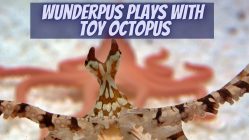Our beloved eight-armed invertebrates are associated in most people’s minds with a lovely, tasty, and healthy meal. As much as we (and all octopus enthusiasts) do not like to think of an octopus as food, the fact is that they do offer a meal full of useful protein. For this reason, the octopus is faced with many dangerous predators during its lifetime. Without a shell for protection, the octopus needed to develop many effective techniques to defend its life.
Defense Mechanisms
Hiding
The hiding place of the octopus, in other words, its den is the first level of protection which keeps the octopus safe from its predators. Octopuses choose small holes or narrow openings to hide, often not much larger than their size. They can construct their dens themselves using small rocks or any other handy material they might find. Once settled in the den, the octopus protects the entrance: it places an arm with its suckers facing outwards and an eye above the arm to surveil any action. Otherwise, it can also cover the entrance to his hideout with more rocks and materials hoping that the den will remain undiscovered by its predators.
Now it is finally time for a nap!
Camouflage
Octopuses are many times compared to the chameleon thanks to their master camouflaging techniques. They can alter both their color and texture to blend in with their surrounding environment. Color alteration is achieved thanks to the cells known as chromatophores, which are located under their skins and contain a sac full of colorful pigments ((black, brown, orange, red, or yellow). By contracting and expanding this sac, the octopus can change the shade of its color, as well as its intensity. The octopus can also imitate spikes, bumps, and ridges in order to appear more intimidating to its attackers. Some species have developed unique techniques as, for example, the Mimic Octopus which is famous for its ability to impersonate other animals, or the Blue-Ringed Octopus which, when feeling threatened by an enemy, can make its blue rings reflect light and make them appear as shining.
Ink
Each octopus is equipped with an ink sack with a gland that produces the ink. When detected by its attacker, the octopus will suddenly release an amount of ink to scare him off or obstruct his vision until it manages to escape. Occasionally, thiner streams of ink are released to confuse the attacker into thinking the octopus is actually a jellyfish.
The opening through which the ink is released, called the siphon or funnel, is the same opening through which bodily waste is expelled. Many people consider this fact quite funny, thinking that an octopus, in fact, ”farts” ink.
Power of the Suckers
When an octopus must engage in battle, its most powerful defense advantage over its enemies are its eight mighty arms, each covered by two rows of suckers. These suckers can attach themselves to the enemy’s skin and allow the octopus to grasp and entangle the enemy. Most of the octopus predators are not flexible enough to disentangle themselves from the suffocating grip of the octopus arms. Even if an enemy manages to cut off one of its arms, this arm will continue to fight independently and the octopus will start regenerating the missing arm immediately.
Poisonous Bite
All octopus are venomous. A poisonous bite to the enemy can paralyze him long enough for the octopus to flee. The poison is produced in the poison gland and released through the parrot-like beak of the octopus. It contains a substance called cephalotoxin which is a strong sedative.
Fleeing
The octopus is able to flee from the battlefield very quickly. It can swim faster by expelling water through the funnel, thus generating a propelling force. Although it may look very funny, walking backwards allows the octopus to increase their speed by using two of their arms as legs while the remaining six alter its shape to make it appear more intimidating.
Most Common Predators
Predators or Prey?
Most of the predators to which we will refer are, at the same time, potential prey for the octopus. Some of the defense mechanisms we described above can be so effective that an octopus attacker can turn into a victim in a matter of seconds. Some battles are so even that they might even end without a winner.
Sharks and Dolphins
Shallow tropical waters are where the octopus meets one of its deadliest predators: the shark. Dogfish sharks, whitetip reef sharks, nurse sharks as well as some deep-water shark species are the most common species to include the octopus in their diet. Dolphins have even developed a special technique in order to deal with the mighty octopus: they shake and toss the octopus on the water’s surface and sometimes grasp it with their teeth before slapping it down onto the water. Still, the fight between these two intelligent beings is a fair one: the smooth skin of the dolphin is ideal for the octopus suckers to latch onto, giving the octopus the chance to defend itself.
Seals and Sea Otters
Marine mammals such as seals and sea otters but even river otters that have come nearer to the coast are a threat for octopuses visiting the intertidal zone.
Moray, Conger, and Wolf Eels
Eels have a strong advantage in comparison to other predators: their snake-shaped body can invade the holes and small openings octopuses use as hideouts. When an octopus seeks refuge to its hiding place, most predators will move on to their next victim but the moray eel is known as the most persistent enemy of the octopus. Their matches sometimes end in a tie, or with the octopus losing an arm or two. Wolf eels also fight octopuses to take over their dens.
Diving Birds
Sea birds and shore birds are both among the predators and among the prey of the octopus. As we know, octopus love feeding on small crustaceans, especially crabs. That is why an octopus will sometimes dare to come out to the intertidal zone in search for this kind of delicacies. When it does, it can become a target by sea birds such as gulls or penguins. On the other hand, Giant Pacific Octopuses have been known to catch birds themselves, namely, gulls, alcids, and pigeon guillemots.
Fish and Rays
Any fish would gladly have a small, stranded octopus away from its den for breakfast, lunch, or dinner! And although small fish do not often dare to snack on something bigger than a hatchling, some larger fish species such as cod, barracudas or scorpion fishes can put on quite a fight to secure a bigger octopus meal. On the other hand, one Giant Pacific Octopus living at the Seattle Aquarium was discovered to feed on fishes as big as the spiny dogfish.
Rays use the element of surprise to capture an off guard wandering octopus: it hides in the sand until the octopus approaches close enough and then, all of a sudden, the ray strikes.
Other Octopuses
Cannibalism among octopuses was believed to exist since many years but it was not until recently that instances have been recorded. In all cases the bigger octopuses acted as predators hunting down octopuses four or five times smaller than themselves.
Although it might sound strange that such intelligent creatures will feed on their own kind, it makes sense considering the nutritious value of the octopus.
Humans
Although humans are not animals and therefore not predators in the strict sense, most individuals of our species consider the octopus as quite the delicacy. There are probably hundreds of recipes on how to cook an octopus. In Korea, the famous dish of San-nakji is, in fact, raw small octopuses.
Fortunately, despite the efficiency of the octopus defense mechanisms, humans are not included in the cases when the predator has become the prey.
True or False: The Octopus Has Many Predators
Scientists argue that not all of the supposed predators are actually capable of hunting and eating an octopus. Senescent octopuses are the octopuses close to the end of their life circle. Once the male octopuses mates and the female witnesses all of the eggs hatching, their life will soon be over. During this stage, octopuses don’t behave normally, they tend not to eat and not to hide in dens, thus becoming an easy target for many opportunistic predators. Orcas are an example of such a predator. These whales that live in the North Pacific are up to twenty feet long, so in theory killing a healthy, active octopus which can hide in small openings would be an impossible task for such a big animal. But if they happen to pass by a senescent octopus crawling outside its den, they would certainly not say no to such a meal, especially if it happens to be a Giant Pacific Octopus.
Boy, what a treat!
























